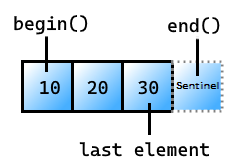join_view class (C++ Standard Library)
Combines the elements of a range of ranges into a single view.
Syntax
template<input_range R> requires view<R> && input_range<range_reference_t<R>> &&
(is_reference_v<range_reference_t<R>> || view<range_value_t<R>>)
class join_view : public view_interface<join_view<R>>;
Template parameters
R
The type of the underlying range. Must satisfy input_range or higher.
View characteristics
For a description of the following entries, see View class characteristics
| Characteristic | Description |
|---|---|
| Range adaptor | views::join |
| Underlying range | Must satisfy input_range or higher |
| Element type | Same as the underlying range |
| View iterator category | input_range up to bidirectional_range depending on the underlying range being iterated |
| Sized | No |
Is const-iterable |
Only if the underlying range is const iterable |
| Common range | Only if the underlying range satisfies common_range |
| Borrowed range | No |
Members
| Member functions | Description |
|---|---|
| ConstructorsC++20 | Construct an join_view. |
baseC++20 |
Get a reference to the underlying range. |
beginC++20 |
Get an iterator to the first element. |
endC++20 |
Get the sentinel at the end of the view. |
Inherited from view_interface |
Description |
backC++20 |
Get the last element. |
emptyC++20 |
Test whether the view is empty. |
frontC++20 |
Get the first element. |
operator boolC++20 |
Test whether the view isn't empty. |
Remarks
The best way to create a join_view is by using the views::join range adaptor. Range adaptors are the intended way to access view classes. The view types are exposed in case you want to create your own custom view type.
This view is useful when you want to combine multiple ranges into a single view.
Requirements
Header: <ranges> (since C++20)
Namespace: std::ranges
Compiler Option: /std:c++20 or later is required.
Constructors
Create an instance of a join_view.
1) join_view() = default;
2) constexpr explicit join_view(R base)
Parameters
base
The underlying range.
For information about the template parameter type, see Template parameters.
Remarks
1) Default-constructs a join_view.
2) Constructs the join_view from base.
Example: join_view
// requires /std:c++20, or later
#include <iostream>
#include <vector>
#include <ranges>
int main()
{
std::vector<int> rg1{1, 2, 3, 4};
std::vector<int> rg2{5, 6, 7};
std::vector<int> rg3{8, 9, 10, 11, 12, 13};
std::vector<int> rangeOfRanges[] {rg1, rg2, rg3};
auto jv = std::ranges::join_view(rangeOfRanges);
for (auto& e : jv)
{
std::cout << e << " ";
}
}
1 2 3 4 5 6 7 8 9 10 11 12 13
base
Get the underlying view.
// Uses a copy constructor to return the underlying view
1) constexpr V base() const& requires std::copy_constructible<V>;
// Uses a move constructor to return the underlying view
2) constexpr V base() &&;
Parameters
None.
Return value
- The returned view is copy constructed.
- The returned view is move constructed.
begin
Get an iterator to the first element in the view.
constexpr auto begin();
constexpr auto begin() const
requires ranges::input_range<const V> && std::is_reference_v<ranges::range_reference_t<const V>>;
Parameters
None.
Return value
An iterator pointing at the first element in the view:

end
Get the sentinel at the end of the view.
constexpr sentinel_t<R> end();
constexpr auto end() const requires range<const R>
Parameters
None.
Return value
The sentinel that follows the last element in the view:
